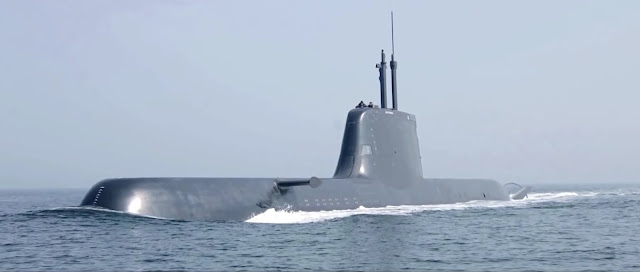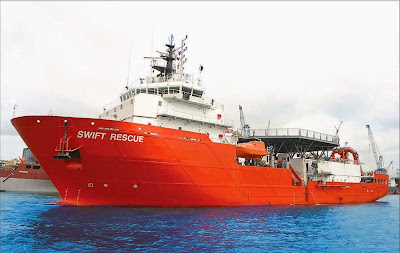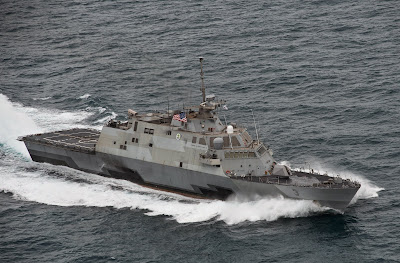 |
| RSS Independence in 2016. Photo : MINDEF |
Smarter, Faster And Sharper?
The official MINDEF news release announcing the launch of the Republic of Singapore Navy's ( RSN ) first of eight littoral mission vessels ( LMV ) on the 3rd of July 2015 screamed : Smarter, Faster And Sharper : Singapore Navy Launches First Littoral Mission Vessel. Personally, I think Bigger, Meaner And Leaner might describe these new ships better. Read on to find out.
 |
| The Littoral Mission Vessel at a glance. Source : MINDEF |
Littoral Mission Vessel
What's a littoral mission vessel? A littoral mission vessel or LMV is simply a large offshore patrol vessel ( OPV ) if you are more familiar with that term. As the name implies, they are supposed to operate in littoral environments, that is, shallow coastal waters not too far from the shore. They are also designed to be modular and configurable for different missions. The 8 LMVs planned are to replace 11 of the RSN's existing Fearless-class Patrol Vessels ( PV ) which have been in service since 1997.
Their primary mission is to ensure the maritime security of the Port of Singapore and the surrounding territorial waters, ultimately contributing towards the seaward defense of Singapore. They are the work horses of the Navy.
 |
The RSN's early generation Patrol Craft was replaced by the
Patrol Vessels in 1997. The PV will in turn be replaced
by the LMV. Source : Republic of Singapore Navy |
After holding a name-the-vessel contest earlier in the year, the RSN selected eight names that reflected the theme of Singapore's nationhood. These are also ideals that Singapore's pioneers and the founding Prime Minister, the late Mr Lee Kuan Yew, fought for, as well as the attributes that they exemplified. They will be named RSS
Independence, RSS
Sovereignty, RSS
Unity, RSS
Justice, RSS
Indomitable, RSS
Fortitude, RSS
Dauntless, and RSS
Fearless. Collectively, they are the
Independence-class Littoral Mission Vessels.
The LMV is jointly designed by local ship builder Singapore Technologies Marine ( ST Marine ) and SAAB Kockums AB of Sweden, working closely with the Defense Science and Technology Agency ( DSTA ), taking into account the unique requirements of the RSN. Apart from submarines, Kockums is also famous for building Sweden's iconic Visby-class stealth corvettes and would no doubt have brought to the table their wealth of experience in the designing and building of low observability vessels.
The contract to build the LMVs was awarded to ST Marine in 2013. The ships are being constructed at ST Marine's Benoi Shipyard at the Jurong Industrial Area. According to MINDEF, the first LMV is scheduled to be delivered in 1Q2016 and all are expected to be fully operational by the year 2020, by which time the existing PV fleet would have reached the end of their operational life after being in service for more than 20 years.
 |
Launch of the RSS Independence at ST Marine's Benoi shipyard
on 3rd July 2015. Source : RSN |
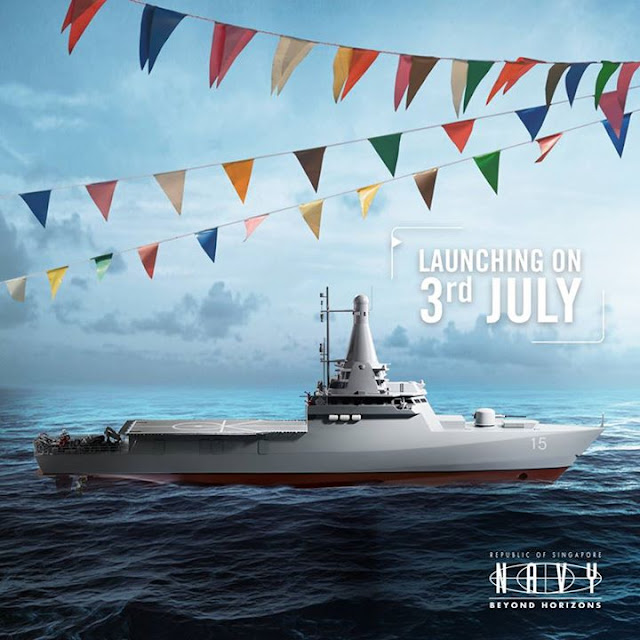 |
RSS Independence was launched by Dr Ivy Lim, wife of the
Minister for Defence Dr Ng Eng Hen. Source : RSN |
One look at the LMV's exterior, especially of the rounded composite mast, and you would have realised that stealth is an inherent part of the ship's design. There are also no funnels to discharge engine exhaust and emit infra-red signature. Stealth technology has found its way to almost every class of modern warships nowadays and the Navy would be foolish not to embrace it.
Not so immediately obvious is the fact that the LMV is also purpose designed around the theme of minimizing manpower requirements. In fact I could argue that the LMV owed its existence mainly to the lack of manpower within the RSN. Anything that can be automated would have been automated. The ship's sensor, weapons and systems are constructed to allow for easy accessibility and simple maintenance. The LMV's layout is also such that all the major command and control centres of the ship are integrated together at the same location at the bridge. This co-location of the Bridge ( command and navigation ), Combat Information Centre or CIC ( sensors and weapons ), the Machinery Control Room or MCR ( engineering ), is known as the Integrated Command Centre and it integrates and synergises the management of navigation, engineering and combat functions.
On the other hand, it could also mean that a hit at the bridge could wipe out the entire command of the ship. To realise how radical this integrated concept is, just take a look at RSN's Victory-class missile corvettes ( MCV ) which are a generation older. The CIC is actually located two decks below the bridge and the two centres are physically linked by a steep flight of spiral stairs. When the ship closes up for Action Station, the commanding officer is at the bridge while his deputy, the executive officer, is in the CIC. That way a single hit cannot take out all the senior command.
 |
LMV sailing across a console displaying a digital map of Singapore :
a networked, everything integrated ship. Source : RSN |
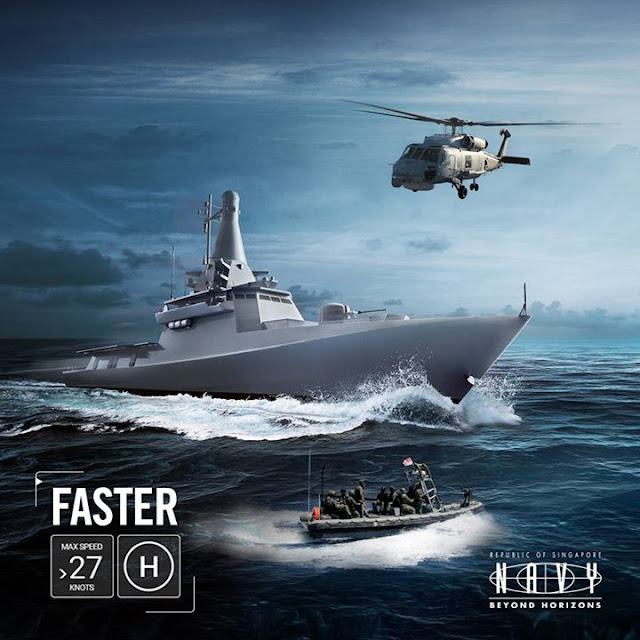 |
The LMV is marginally faster than the PV which has a
maximum speed of 22 knots. It has a helideck that can
accommodate a medium-lift helicopter including the S-70B
shown above. It can also deploy up to two RHIBs. |
 |
Superior suite of sensors : LMV superimposed on digital map of
Australia / Indo-Pacific. Could an up scaled version
be the Armidale-class replacement that the RAN is looking for? Source : RSN |
LMV Characteristics
Length : 80m
Beam : 12m
Draught : 3m
Displacement : 1250 tonnes
Speed : In excess of 27 knots
Endurance : 3500 nautical miles ( 14 days )
Complement : 23 ( including 5 Officers )
Engines : 4 x MTU 20V 4000 M93L diesel engines.
Configuration : Combined Diesel and Diesel ( CODAD )
Sensors : Thales NS100 3D surveillance radar
Kelvin Hughes SharpEye Navigation Radar
Stelop Compass D Electro-Optic Director
Stelop 360 All-Round Surveillance System
Weapons : OTO Melara 76.2mm Super Rapide Main Gun
Rafael 25mm Tyhoon Remote Weapon Station
2 x OTO Melara 12.7mm Hitrole RWS
12 x MDBA VL-Mica
2 x LRAD Long Range Acoustic Device
2 x Water Cannon System
Others : Helicopter Deck for one Medium Lift Helicopter
Launch and Recovery System for 2 x RHIBs
or Protector USV
MTU 20V 4000 M93L Diesel Engines
MTU has been providing diesel engines to power RSN ships for many years. The MCVs, PVs, FFGs are all powered by MTU diesels. RSN has now selected MTU's 20V 4000 M93L diesel engine for the LMVs. This compact engine has 20 cylinders in V configuration. The cylinders have a bore of 170mm and a stroke of 190mm so each will have a displacement of 4.313 litres. Multiply that by 20 and you get the total displacement of 86.26 litres for each engine. Fuel consumption is said to be 1135.7 litres per hour and each engine weighs 15587 kg. The LMV will be equipped with four of these engines, known for their low consumption and long service life, with each unit producing 4300kW (5766bhp) at 2100 rpm. From the product data sheet " MTU Series 4000 diesel engines offer unrivalled power density in terms of volume-to power ratio and power-to-weight ratio. ". A good choice for a small vessel.
 |
The MTU Series 4000 V20 Diesel displacing 86260 cc.
Four will power each LMV. Source : MTU |
Thales NS100 3D Naval Air And Surface Surveillance Radar
The NS100 is Thales' new generation of 3D air and surface surveillance naval radar which combines state of the art S Band Active Electronically Scanned Array ( AESA ) antenna technology and dual axis multi-beam processing. This new concept enables simultaneous detection of a large variety of targets from fast jets to hovering helicopters to sea skimming missiles to high diving munitions to small UAVs, all in one single mode.
The NS100 can be integrated with other sensors like the Scout Mk3 FMCW Radar for LPI ( Low Probability of Intercept ) and dual band surface surveillance, IR camera for nearby situational awareness, AIS ( Automatic Identification System for ships ), ADS-B ( Automatic Dependent Surveillance - Broadcast for air traffic management ), and IFF ( Identification Friend or Foe ) interrogator and transponder. This creates a multi-sensor integrated solution saving space and also optimizes overall field of view when all sensors are positioned together topside.
The NS100 has an instrumented range of 200km. It is capable of 3D air surveillance and weapon support for active missiles, 2D surface surveillance, surface gun fire support, jammer surveillance and IFF interrogation support. It has a physical dimension of 3m by 3m. Its MTBCF ( mean time before critical failure ) is 3000 hours. A mean radar for a small ship.
 |
| The Thales NS100 3D radar. Source : Thales |
Kelvin Hughes SharpEye Navigation Radar
The SharpEye solid state radar system is a digital radar technology that is available in X and S Band frequencies. It is an affordable navigation and surface search pulse Doppler radar sensor offering high reliability ( solid state, no moving parts, no magnetron, low maintenance ), low cost of ownership, and improved detection ranges especially of small targets in clutter ( think inclement weather, high sea states ).
 |
| The Kelvin Hughes Sharpeye Navigation Radar's upmast transceiver. Source : Kelvin Hughes |
 |
| Traditional radar in heavy rain : details lost in heavy clutter |
 |
| SharpEye in heavy rain : minimal clutter |
STELOP 360 All-Round Surveillance System and Compass D Electro-Optic Director
There is not much publicly available information regarding these STELOP products but I guess the 360 could be a all-weather day and night high resolution camera system. The Compass D could be an imagery system for target identification. STELOP is a subsidiary company of ST Engineering, a sister company of ST Marine.
OTO Melara 76/62 Super Rapid Gun Mount
The Italian made OTO Melara 76.2mm Super Rapid naval gun can be found on almost every major RSN surface combatant starting from the Victory-class missile corvettes in the eighties, with the trend continuing in the Fearless-class patrol vessels, the Endurance-class landing platform dock, the Formidable-class stealth frigates and now the LMVs. This light weight and space saving 62 calibre gun can be mounted on relatively small ships and has a maximum rate of fire of 120 rounds per minute. It can be used against surface as well as air threats, including missiles, up to a maximum range of 16km. The barrel can be elevated from -15° to +85°. Automatic loading is provided through a below deck revolving magazine which holds 80 rounds and rapid reloading is easily undertaken even during firing action by two ammunition handlers.
 |
| The OTO Melara 76/62 Super Rapide Gun Mount on the missile corvette RSS Valour circa 1999. Source Wikipedia |
Rafael 25mm Typhoon RWS
The Rafael Typhoon is a light weight, stabilized, remotely controlled weapons station that can be mounted with various small and medium calibre guns, as well as missiles, grenade launchers and even decoys. In this case it is mated with a M242 Bushmaster 25mm chain gun. The on-mount electro-optical director has colour CCD for day operations, FLIR for night operations, and an eye-safe laser range finder. It has its own ballistic computer for calculating firing solutions and an automatic tracker. The entire mount weighs less than 1000kg and does not require deck penetration making it ideal for small vessels. One stern facing Typhoon RWS will be installed on the LMV. They will be used for force protection especially against asymmetrical threats like a swarm of fast boats. They are also found on the RSN's Endurance-class LPD and Formidable-class FFGs with two mounted on each ship.
 |
The 25mm Typhoon RWS is also known in the USN as the
Mk38 Mod2 seen here on DDG-103 circa 2013.
Note the on-mount EO director. Source : US Navy. |
OTO Melara 12.7mm Hitrole RWS
The OTO Melara 12.7mm Hitrole remotely controlled naval turret is rather similar to the Typhoon RWS except it has a smaller calibre. Hitrole is the acronym for Highly Integrated Turret, Remote, Overhead, Light, Electrical. It is gyro-stabilized. Two of these would be installed at the bridge-wing area, port and starboard. They would replace the traditional 4 x Chartered Industries of Singapore CIS 0.5in Heavy Machine Guns mounted all around the bridge-wing on the older RSN vessels.
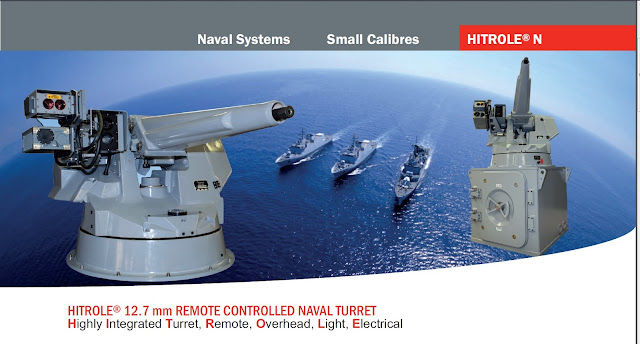 |
The OTO Melara 12.7mm Hitrole Remote Controlled Naval Turret.
Source : OTO Melara |
MBDA Missile Systems VL-MICA
The MBDA VL-Mica is a short range vertical launch surface to air missile for point and close-area defense. It offers all weather capability against a wide range of aerial threats including aircrafts, helicopters, missiles, precision guided munitions and smart bombs in a modular and compact setup. It also features autonomous guidance and extremely short reaction time and has multiple target capability for defense against saturation anti-ship attacks. The MICA missile is available with two different seekers - Infrared (IR) and Radio Frequency (RF), both highly resistant to countermeasures and decoys, ensuring a high hit probability. The VL-MICA will be deployed in a 12 cell vertical launch system ( VLS ) in the forward section of the LMV just aft of the OTO Melara main gun. They have never been previously deployed in the RSN and are far more capable than the Mistral missile found on the PVs and perhaps the Barak missile on the MCVs as well.
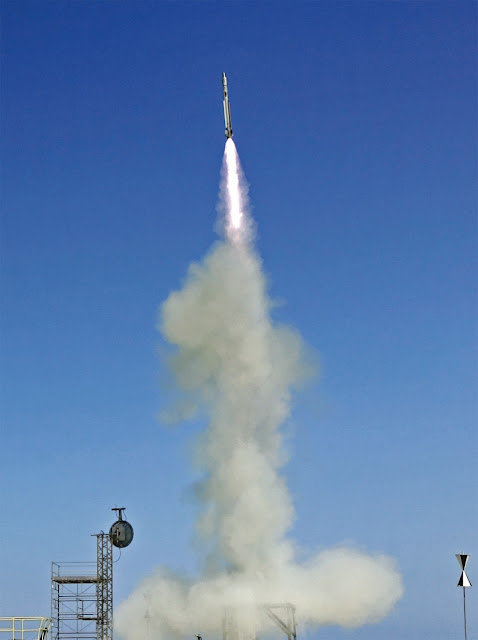 |
| The MBDA VL-MICA at launch. Source : MBDA |
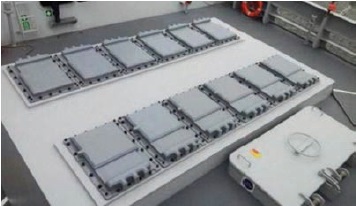 |
The VL-MICA vertical launch system seen here in a 12 cell configuration.
Source : MBDA |
 |
VL-MICA missiles with heat seeking IR seeker ( top ) and
radar guided RF seeker ( bottom ). MBDA |
 |
| VL-MICA with IR seeker inside VLS. Source : MBDA |
The LRAD 1000RX
LRAD Corporation has many different products for its clients from the ultra portable to the heavy weight for vessels and land installations. I must admit I am not certain if it is this particular model that the RSN has chosen for the LMV but the 1000RX resembles the shape of the LRAD seen in RSN's full scale bridge mockup.
The LRAD 1000RX is a long range acoustic hailing device. It projects sound in a focused and directional manner to standoff distances said to be up to 3000m. It broadcasts clear, authoritative voice commands and a whole range of eardrum busting warning tones to modify the behavior of potential threats and thus provide additional time to escalate the use of force if necessary.
It is rugged, simple to operate, has low power requirements and has an all-weather capability. It can be remotely controlled over an IP network and can be integrated with cameras and high intensity xenon lights. From the product brochures " As part of a layered communication and EOF ( escalation of force ) strategy, LRAD systems provide military personnel additional time and distance to distinguish between security threats and innocent civilians before employing lethal force ".
Two would be installed at the bridge wing.
 |
| The LRAD 1000RX mounted on a warship. Source : LRAD |
 |
| Front view of the LRAD 1000RX with camera and xenon light. Source : LRAD |
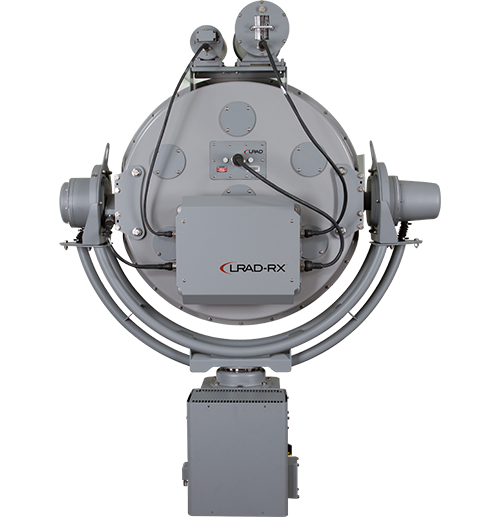 |
| Rear view of the LRAD 1000RX with camera and xenon light. Source : LRAD |
Water Cannons
The LMVs are also equipped with water cannons as part of their non-lethal arsenal. Two would be installed at the bridge wing next to the LRAD.
Lack Of Anti-Submarine Capability
A quick look at the sensors and weapon systems and you would have noticed that the LMV does not have a sonar system for submarine detection. Neither does it have any torpedo tubes, anti-submarine rockets or depth charges, the staple for any self-respecting anti-submarine platform. Of course this omission is intentional. The LMVs are not supposed to be ASW assets just as their predecessors, the Fearless-class PVs are currently solely used for coastal defense and maritime security operations only.
Of the original twelve PVs commissioned by the RSN, six are of the ASW variant with bow mounted sonar and torpedo launchers. They are known as the Anti-submarine Patrol Vessels or APVs. One of the APV, RSS Courageous, was badly damaged in a collision with a container ship in 2003 and was stricken from the navy list.
The remaining five APVs subsequently had their ASW equipment removed and for the past few years had been performing normal patrol duties with the other six non-ASW sister ships. This could be due to the fact that since 2005 the RSN had acquired a better ASW platform in the form of the Formidable-class frigates, and together with the Victory-class corvettes which are also capable ASW ships ( variable depth sonars ), they made the APVs redundant. ( Note : the Victory-class seems to have also lost their ASW capabilities, after the Scan Eagle UAV upgrade )
At the same time, the threat of terrorism post 9/11 and the surge in piracy activities around the Straits of Melaka and surrounding Indonesian waters meant that there was and still is an increased need to step up maritime security operations in and around Singapore. That burden fell on the shoulders of the eleven APVs and PVs and the men and women of the 182 SQN and 189 SQN. These brave warriors reportedly spend up to a third of their time on sea duties away from the comforts of their home and loved ones. With the arrival of the new LMVs which are bigger and more sea worthy, at least the sailors can have more room and more comfort while on their routines.
 |
Keeping Singapore Safe. The iconic Marina Bay Sands Hotel
and Casino stand in the back ground. Source : Republic of Singapore Navy. |
Missions and Modules
The LMVs are well equipped for routine territorial waters patrol duties but their size and endurance and the helicopter landing deck means that they can also be adapted to take on more demanding missions further afield with the appropriate mission module. For example, adding a containerized medical module for Humanitarian and Disaster Relief ( HADR ) missions is a no brainer. Other mission modules may include mine countermeasures module ( MCM ), intelligence, surveillance and reconnaissance module ( ISR ), oceanography and undersea surveillance module, and perhaps a special operations module. Needless to say, LMVs can also be called upon to perform the usual escort duties and provide naval gunfire support.
Littoral Mission Vessel vs Littoral Combat Ship
Though build along similar concepts of multi-mission adaptability for coastal operations, they are not to be confused with the US Navy's Littoral Combat Ship ( LCS ) which comes in two distinctive versions, the monohull
Freedom-class ( LCS-1 ) and the trimaran
Independence-class ( LCS-2 ). It is with LCS-2 that the most confusion may arise for the uninitiated as they are both known as "
Independence-class " littoral something.
 |
USS Freedom ( LCS-1 ) Littoral Combat Ship in transit off
Southern California in a USN Photo taken on 28th Apr 2015. |
 |
Potential name confusion : The Independence-class Littoral Combat Ship
USS Independence ( LCS-2 ) at RIMPAC 2014. USN Photo. |
Bigger, Meaner and Leaner
Now you have a better idea of what the LMV is and what it is capable of :
Bigger : At 1250 tonnes and 80m, the LMV is a lot bigger than the PV which is only 55m in length and about 500 tonnes. Bigger means better sea keeping, better endurance, space for more weapon systems, space for bigger and more capable systems, more space for working and living, space for future upgrades ... and also more areas to clean before First Lieutenant rounds.
Meaner : The LMV has the same 76mm main gun as the PV, but everything else is superior. VL MICA instead of Mistral for air and missile defense, additional 25mm chain gun, remotely controlled instead of manually manned 12.7mm HMG, options for non-lethal response, better radar, better electro-optics sensors, capability to carry a medium-lift helicopter, UAV, USV and UUV, infusion of stealth technology ... the list goes on.
Leaner : The entire ship manned by just 23 men. The smaller PV needed 30 and a typical sea patrol involves 30 to 35 personnel. And under the multi-crew concept each PV has 2 sets of deployable crew. A WWII era destroyer escort of a similar tonnage would have required something like 15 officers and 200 enlisted men to operate. Until DSTA, DARPA or somebody finds a way to build a 1250 tonne USV or a squad of robotic sailors, 23 men is about as few as you get away with. Don't anyone forget the domestic before the First Lieutenant rounds. Some things just cannot be automated!
Food For Thought
The RSN's Patrol Vessels are currently less than 20 years old and could have been upgraded to extend their service life for another 10 years or more. The Singapore Armed Forces is known for its frugality and would not have replaced an old equipment until it has exhausted all upgrade options or when it has become economically unviable to continue using or maintaining that weapon system. The fact that these PVs are being replaced a little earlier than usual means there has to be other reasons behind that decision. Most probably it reflects the dire manpower situation within the Navy.
Declining birth rates have reduced the annual intake of conscripted personnel. At the same time career naval personnel are leaving the Navy for the private sector. Even for those who remain with the service, how many would voluntarily want to be in the PV squadron with their punishing patrolling routines? I would rather be with the frigates if I had the choice. There are simply too many PVs that require too many men ( and women ) to staff.
So RSN's solution is to use technology to overcome this shortage in manpower. Get rid of the PVs, replace them with fewer but bigger ships that each require less manpower resources to operate. Make the ships more appealing to work in and more comfortable to live in and hopefully that will make staff retention easier.
Fortunately, with regards to the shortage in manpower, new technology is not the only trick up the RSN's sleeves. After 48 years of existence, the Republic of Singapore Navy has a vast pool of reserve personnel to depend upon in times of crisis. They maintain their proficiency through annual recalls ( known as in-camp training ) that frequently involves a period of sea deployment on their respective vessels. Already the RSN has staffed an entire ship with reserve personnel. The missile corvette RSS Vigilance is a such an example.
This article is a tribute to the men and women of the Patrol Vessel Squadron of the Republic of Singapore Navy. They are the unsung heroes that have kept the waters of Singapore safe all these years.

